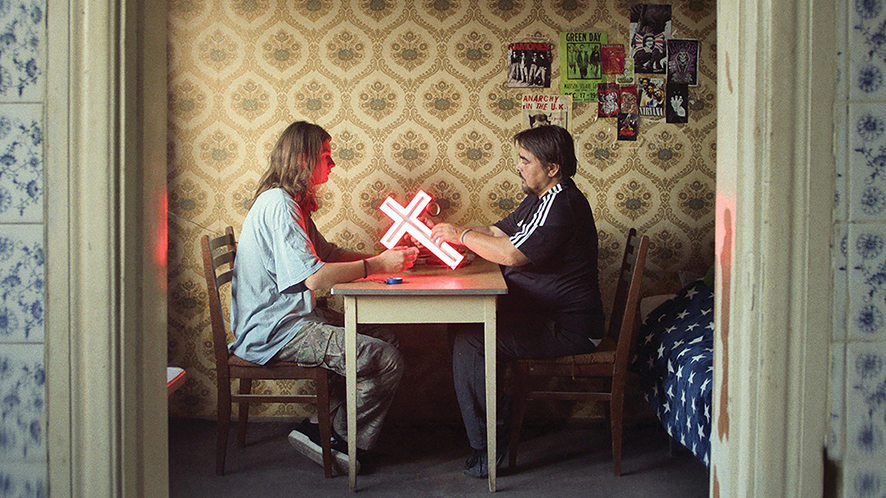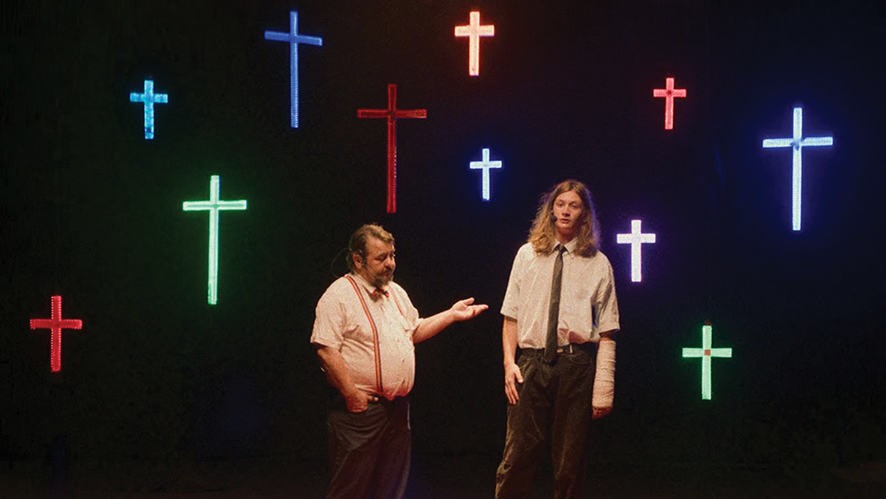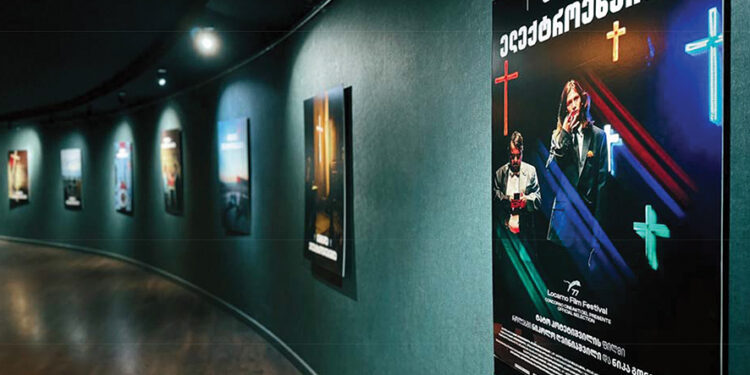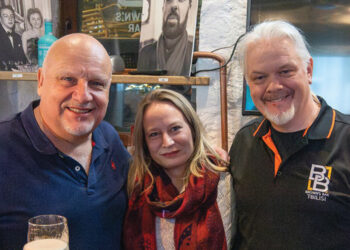There are films that deliver stories, and there are films that rewire perception. Tato Kotetishvili’s Holy Electricity belongs firmly to the latter category. The Georgian director’s debut feature, which premiered at Locarno in 2024 and promptly carried off the Golden Leopard for the “Cineasti del presente” competition, seems modest in its premise: two cousins in Tbilisi stumble upon a suitcase full of metal crosses, convert them into neon crucifixes, and try to sell them door-to-door. Yet this bare plot proves inexhaustibly fertile. Out of scrap metal and LED tubing Kotetishvili fashions a meditation on faith, commerce, kinship, and the fragility of survival in a city perpetually oscillating between tradition and reinvention. The film is showing in theaters throughout August and is still available — with English subtitles.
At first glance the premise resembles a folk tale: a pair of underdogs encounter a magical object and seek to transform it into livelihood. But Kotetishvili does not work in parable’s simple moral hues. His camera lingers instead on the city’s textures—crumbling courtyards, rusting gates, and stairwells where light flickers with the uncertainty of the national grid. The cousins’ neon crosses, glowing like miniature storefront signs, enter these spaces less as commodities than as experiments. Each doorway becomes a laboratory for testing how much belief, nostalgia, or irony still attaches to the sign of the cross when it is wired to an outlet and hums faintly like a cheap refrigerator.
This oscillation between sacred symbol and consumer trinket echoes Émile Durkheim’s foundational claim that society itself is the object of worship in religion: the cross, once detached from liturgy, reveals the community’s own shifting allegiances. In a post-Soviet, neoliberalizing Tbilisi, faith can be a private anchor, a public badge, and—here—a last-resort business venture.

Kotetishvili cast non-professional actors and relied heavily on improvisation. The result is a porous realism in which documentary textures bleed into fiction. The cousins are not ciphers but vivid presences—awkward, endearing, fragile. Their improvisations mirror the improvisations of the city itself: how does one earn dignity when the structures of labor and belonging collapse into informal economies? One cousin identifies as gender-nonconforming, which inflects the sales encounters with additional social voltage. Each doorstep, each hesitation before a closed door, is a test of Georgia’s capacity for hospitality, tolerance, and recognition.
Anthropologists of religion often stress how rituals are reinvented under pressure. Here we watch a ritual economy at work: the cross, stripped from liturgical context, enters a domestic transaction. A buyer weighs its glow like one might a lamp; the cousins’ patter acquires the rhythm of street preachers crossed with salesmen. Max Weber’s story of “disenchantment” seems, for a moment, to short-circuit. In an age supposedly drained of magic, neon tubing becomes a vehicle of re-enchantment, smuggling mystery back into apartments where the light switch itself is an uncertain promise.
More than a backdrop, Tbilisi is the third protagonist of Holy Electricity. Kotetishvili’s patient, frontal framings present the city as a series of thresholds—doorways, alleys, balconies—through which flows an endless negotiation between interior and exterior, household and street. Henri Lefebvre once argued that urban space is “produced” rather than given, a palimpsest of planning, practice, and imagination. Kotetishvili visualizes precisely this production line. Each sale maps another fragment of the metropolis; each refusal charts a new contour of exclusion. What emerges is a cartography of contemporary Tbilisi in its minor keys: intimate, improvised, stubbornly alive.
Critics have compared the film to Paper Moon for its ragged entrepreneurial duo, but the kinship is partial. If Bogdanovich’s film was sentimental Americana, Kotetishvili’s belongs to a deadpan European lineage that stretches from Aki Kaurismäki to early Jim Jarmusch. Static compositions, abrupt cuts, and an undercurrent of mordant humor place it closer to a city symphony in fragments than to a road movie. The cousins go nowhere; instead, the city comes to them, door by door, silence by silence.
The film also seems to restage Walter Benjamin’s famous thesis on aura. In Benjamin’s view, mechanical reproduction diminishes the aura of singular artworks. The neon crosses, mass-produced from scrap, appear to prove his point—each is a disposable icon, stripped of consecration. Yet Kotetishvili insists on filming the encounters rather than the objects. Aura migrates from the cross to the relation: the awkward smile exchanged in a dim hallway, the fragile dignity of a pitch refused without cruelty, the flicker of recognition between seller and buyer. If Benjamin sought aura in the artwork, Kotetishvili finds it in the interstices of encounter, in gestures that carry more holiness than the hardware itself.

The cross in Georgia is overdetermined. It graces the national flag, crowns hills, decorates apartment interiors. Yet its ubiquity risks a flattening of meaning. Holy Electricity revives the symbol through kitsch and improvisation. A neon cross does not parody belief; it re-situates it. It becomes a vernacular technology, a plug-and-play sacrament for households where faith competes with utility bills. The irony is gentle, not corrosive. Kotetishvili’s cousins are not iconoclasts. They are scavengers of meaning, conducting current between faith and subsistence.
What makes the film luminous is its refusal to moralize. There are no villains, no pieties, no grand sermons. Instead we witness tenderness in unlikely places: in the cousins’ fumbling care for one another, in the buyers’ tentative curiosity, in the city’s willingness to accommodate absurdity. Comedy hovers always on the edge. The neon crosses glow with a faintly ridiculous charm, yet their ridiculousness shades into poignancy. Faith, after all, has often thrived on absurdity. To believe in the light of a flickering diode is not so distant from believing in a mystery no eye can see.
In recent years, Georgian cinema has emerged as one of the most incisive in Europe: elliptical, socially astute, and formally daring. Holy Electricity extends that reputation. It is not a film of grand pronouncements but of small shocks, little surges of recognition. It reminds us that culture is never static, that symbols are never fixed, that survival itself can be a form of art.
More broadly, it speaks to a global condition. Across the world, from Rio’s hillside chapels to Manila’s neon-bedecked jeepneys, sacred forms blend with commercial light. Kotetishvili’s film gives this bricolage a face, a rhythm, a fragile grace. In doing so, it electrifies a question that cuts across borders: what does belief look like when survival itself has become an improvisation?
The answer, in Holy Electricity, is a glow both comic and tragic, ephemeral yet enduring. A faith plugged into the wall socket, humming with the possibility that holiness can still be salvaged from the scrapyard.
By Ivan Nechaev














